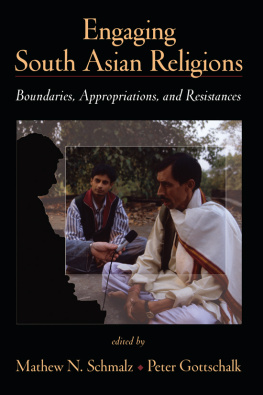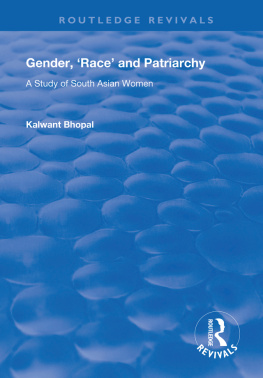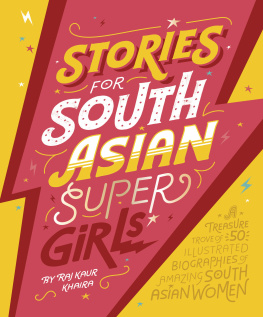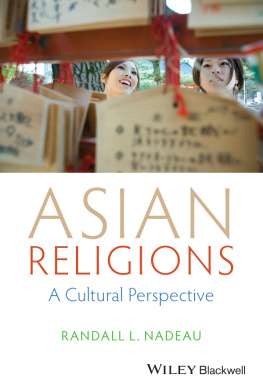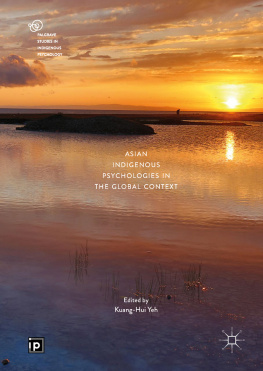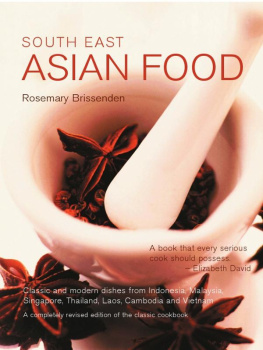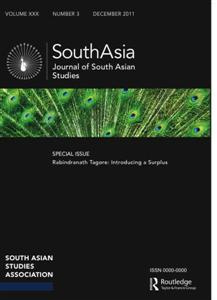SUNY Series in Hindu Studies
Wendy Doniger, Editor
ENGAGING
SOUTH ASIAN
RELIGIONS
Boundaries,
Appropriations,
and Resistances
EDITED BY
Mathew N. Schmalz
and
Peter Gottschalk

Cover: Photo Reframing Ramesh Tripathi, Nandlal Singh, and the nearly absent ethnographer by Peter Gottschalk. Concept by Peter Gottschalk.
Design by Mariah E. Reisner, New Media Lab, Wesleyan University.
Published by State University of New York Press, Albany
2011 State University of New York
All rights reserved
Printed in the United States of America
No part of this book may be used or reproduced in any manner whatsoever without written permission. No part of this book may be stored in a retrieval system or transmitted in any form or by any means including electronic, electrostatic, magnetic tape, mechanical, photocopying, recording, or otherwise without the prior permission in writing of the publisher.
For information, address State University of New York Press, Albany, NY
www.sunypress.edu
Production by Kelli W. LeRoux
Marketing by Michael Campochiaro
Library of Congress Cataloging-in-Publication Data
Engaging South Asian religions : boundaries, appropriations, and resistances /
edited by Mathew N. Schmalz and Peter Gottschalk.
p. cm. (SUNY series in Hindu studies)
Includes bibliographical references and index.
ISBN 978-1-4384-3323-3 (hardcover : alk. paper) 1. South AsiaReligion.
2. Hinduism. I. Schmalz, Mathew N., 1964
II. Gottschalk, Peter, 1963
BL1055.E65 2010
200.954dc22
10 9 8 7 6 5 4 3 2 1
For
Ramachandra Pandit
Rakesh Ranjan
Achutya Nand Singh
And in memory of
Ram Shankar Dubey
Hriday Nath Pandey
Jaideo Singh
Ram Karan Singh
FIGURES
INTRODUCTION
Engaging South Asian Religions
PETER GOTTSCHALK AND MATHEW N. SCHMALZ
PARADIGMS
T he fact that the term Hinduism did not exist until the late eighteenth century (). The additional fact that Hindus played a critical role in the addition of this wordand its non-English equivalentsto their various vocabularies shows that, despite the asymmetries of power, this played out in no simple active-passive binary: South Asians practiced some agency no matter how constrained the spaces afforded to them by Western control. And, of course, Western-South Asian engagements occurred both before and after the two centuries of direct British rule.
Complexities abound in this history of engagement. While and his fellow self-proclaimed Orientalists for being too sympathetic with the Indian natives. Britons like Major General Charles Hindoo Stuart assumed Indian idioms of practice and accepted local beliefs before the advent of Victorian social constraints pressured such servants of the East India Company to stay on their side of an increasingly racialized social boundary. Meanwhile, reformer Rammohan Roy urged the establishment of Indian schools incorporating European forms of knowledge, and later, some Muslims criticized Sir Saiyid Ahmed Khan for betraying Islam by introducing Western science into a curriculum shared with Islamic topics in his Anglo-Muhammadan University. Post-independence transnational flows of people, information, and epistemologies have confounded supposedly self-evident views of who and what, exactly, is Western and South Asian. Clearly, historical change, social diversity, and individual choices problematize any simple narrative of cultural interaction.
Yet centralwhether explicitly or implicitlyto these engagements have been the various epistemological projects employed by all sides to understand their worlds. As the early modern period gave way to the modern, and casual European contact changed to systematic cultural, textual, social, and theological study, the notion of what it meant to know Indiansand the methods of doing sochanged, as did Indian opinions about and approaches to what should be known. Within Western ways of knowing South Asian communities, no category served longer and more centrally than religion. Europeans and, later, Americans investigating the Subcontinent often took religion as the common distinguishing character of cultures there because they viewed their own cultures as decreasingly religious. In other words, religion served as a key category, a central concern and an essential characteristic in Western attempts to know South Asia and its cultures, even as they conceived themselves as less committed to religion. Paradoxically, throughout this period, various Christian social and political movements continued to provoke significant transformations in these supposedly secularized societies.
This volume attempts to contribute to the scholarly discussion regarding Western-South Asian engagements by bringing particular focus to the interaction of, interchange among, and interpretation of epistemological and interpretative paradigms as practiced by all sides. By providing nine studies of such engagements, we hope to offer insight not only into the diversity of European and American approaches and indigenous responses but also into the interpenetrations attempted, avoided, and accomplished that have gone unacknowledged. We also focus on paradigms to bring attention to the explicit and implict epistemological logics that have shaped the variety of Western-South Asian engagements. By paradigms, we refer to more than ideology or perspective. Instead, the term points to an intellectual framework that, in the words of Pierre Bourdieu, determines the questions that can be asked and those that are excluded, the thinkable and the unthinkable; being both received achievement and a starting-point, it is a guide for future action, a programme for research to be undertaken, rather than a system of rules and norms (Bourdieu 2000, 15). Of courseas described by , the scholar most responsible for popularizing the termparadigms are not permanently fixed, and each can shift when experience significantly exceeds the expectations engendered through the paradigm. A focus on the paradigms in practice in Western approaches to South Asian religions will hopefully prompt more critical engagement with contemporary paradigms as well as conventional categories and terms, not least of which is, of course, religion.
The eventual dominance of British rule in South Asia often obscures a full recognition of the presence of other Europeans who preceded them there. Nevertheless these Westerners made the first set of consistent engagements with Indians. Portuguese settlement in 1500 predated the British arrival by more than a century. The Dutch established themselves on the Subcontinent a decade before the British, the Danes soon thereafter, and the French in the last third of the seventeenth century. Each settlement was motivated originally by profit, its members commonly organized in trading companies by their respective governments, its presence tolerated by indigenous states out of an interest in commercial, artistic, and/or cultural exchange. Yet not all Europeans who visited South Asia at this time had commercial interests. Instead, many arrived as journeyers on the nascent, globalized web of intercontinental travel for which the European voyages of discovery served as pathfinders. Increasing advancements in navigation and shipbuilding that would only eventually overtake previously superior Arab and Chinese accomplishments, would allow trading enterprises to morph into imperial endeavors.
But before this materialized fully, Catholic and Protestant missionaries made their difficult ways to the Subcontinent and elsewhere with conversion their ostensible intent. Although many Europeans categorized South Asians through the medieval Christian division of the humanity into pagans, Jews, and Christians (with Muslims as either pagans or heretics), others found alternative arenas of commonality and difference. For example, the Portuguese developed a relatively nuanced taxonomy of civilizations that included both India and Europe; he quite controversially proclaimed the Bible to be the fifth, flawless, Veda. Due to the precarious trade situation for the first two and a half centuries of European presence, the proselytizers contended with not only an often disinterested populace but also nervous merchants who did not want to offend local rulers. Therefore, the earliest European interest in South Asian religion evolved through theological paradigms and mercantile interest in an environment in which they, initially, enjoyed very little leverage.

